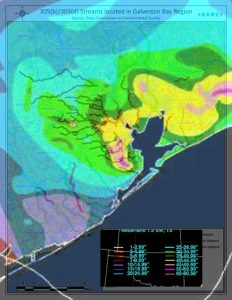So what’s with all the silt?
I’ve lived along Buffalo Bayou for 30 years. I’ve seen big storms and big floods and in all that time, but I never saw anything like the silt from Harvey. It was as though a silt factory in Katy broke and the contents washed into the park.
Well, it turns out, there is a silt factory in Katy, also everywhere else.

This image shows the close in part of the Galveston Bay watershed. Every drop of water that lands on the watershed flows to Galveston Bay. The colors show how much rain fell on the watershed during Harvey. Spoiler alert, it was a lot of water!
Meet the Galveston Bay watershed. It consists of all the land which, if it rains there, that rain will end up in Galveston Bay. Buffalo Bayou Park is one of the lasts places the water flows through on its way to the bay. The Galveston Bay watershed extends all the way to Dallas, but we are interested right now in the nearby streams and waterways. They are the ones that got hammered by Harvey.
In every flood, someone makes sure to mention that a car can be swept away by 24 inches of rushing water. The warning is meant to illustrate the principle that the size of what can be carried by a given depth of water is determined by how fast the water is moving. 24 inches of still water is no problem, but get that water moving fast enough and good-bye car.
The speed of water is determined by the width of the channel. If you squirt water through a water pistol, the tiny opening will force the water to move fast enough to soak your little sister across the room. But, pour a cup of water on a table and it just oozes the floor. The water pistol is a very small channel. The table is a very large one.
Harvey brought us a LOT of water. As that water rushed over the land, streets, storm sewers, rivers, streams, bayous and ditches, it carried off everything it could move. Since the soil in this part of Texas is made up mostly of silt and clay, the stormwater picked up a lot of silt. As the water slowed down (around bends, through wider areas, and during pauses in the deluge) the big things dropped out of the flow, but smaller particles (like silt) just kept moving. Right into the park.
The layout of the park did exactly what it was supposed to do. It slowed the flow of the water by letting it spread out over wide swaths of land (table top vs. water pistol). This is by design. Slowing the flow prevents erosion, allowing the water to nourish the land rather then scour it. It also lets the silt drop out before it reaches the ship channel and challenges the commercial life of the city. And so, Buffalo Bayou Park was given the gift of silt. About 70,000 tons of it.

